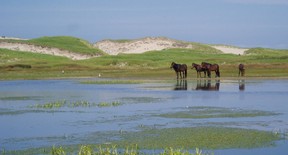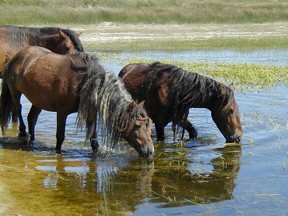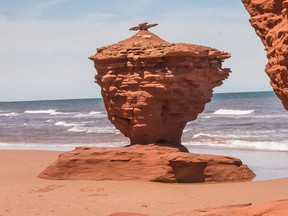The island's wild horses have survived 200 years of Atlantic hurricanes by sheltering in groups beside sand dunes
Author of the article: Tristin Hopper
Publishing date:Sep 26, 2022

Wild horses run on the grasslands of Sable Island.
PHOTO BY JENNIFER NICHOLSON/HANDOUT
Hurricane Fiona has flattened scores of homes and killed at least one person, but there is a spot of good news amid all the destruction: The famed wild horses of Sable Island appear to have weathered the storm without incident.
Sable Island is a 44 km-long, crescent-shaped sandbar located about 300 kms east of Halifax. The island is most famous for a population of around 500 wild horses that are believed to be the descendants of mounts that escaped in the 18th century.
On Saturday morning, as Atlantic Canadians took stock of homes and villages smashed to timbers by the storm, the Sable Island horses emerged from hiding and were soon back to grazing and whinnying on beaches now strewn with debris.
“By late morning (Saturday), horses had emerged from sheltered areas and were grazing, grooming, and engaged in their usual activities,” read a weekend update by the Sable Island Institute, a non-profit devoted to the conservation of the isolated island.
Storms are nothing new to Sable Island, as evidenced by the more than 350 historic shipwrecks peppering its small coastline.
The island is devoid of the usual landforms that can cushion the impact of a severe storm. There is no bedrock of any kind; Sable Island is exclusively composed of sand and the occasional pebble of gravel. The island’s sole tree is a deformed pine planted as part of a failed 1950s experiment.
Due to its isolated location, the island is vulnerable to extreme weather coming from any direction, and is known to vary wildly in size and shape thanks to wave erosion and the near-constant removal of sand due to high winds.
Despite this, the Sable Island horses have successfully weathered more than 200 years of Atlantic hurricane seasons. Their typical strategy is to gather tightly together between large dunes, the youngest and most vulnerable horses to the centre, with the strongest adults to the outside.
Hurricane Fiona has flattened scores of homes and killed at least one person, but there is a spot of good news amid all the destruction: The famed wild horses of Sable Island appear to have weathered the storm without incident.
Sable Island is a 44 km-long, crescent-shaped sandbar located about 300 kms east of Halifax. The island is most famous for a population of around 500 wild horses that are believed to be the descendants of mounts that escaped in the 18th century.
On Saturday morning, as Atlantic Canadians took stock of homes and villages smashed to timbers by the storm, the Sable Island horses emerged from hiding and were soon back to grazing and whinnying on beaches now strewn with debris.
“By late morning (Saturday), horses had emerged from sheltered areas and were grazing, grooming, and engaged in their usual activities,” read a weekend update by the Sable Island Institute, a non-profit devoted to the conservation of the isolated island.
Storms are nothing new to Sable Island, as evidenced by the more than 350 historic shipwrecks peppering its small coastline.
The island is devoid of the usual landforms that can cushion the impact of a severe storm. There is no bedrock of any kind; Sable Island is exclusively composed of sand and the occasional pebble of gravel. The island’s sole tree is a deformed pine planted as part of a failed 1950s experiment.
Due to its isolated location, the island is vulnerable to extreme weather coming from any direction, and is known to vary wildly in size and shape thanks to wave erosion and the near-constant removal of sand due to high winds.
Despite this, the Sable Island horses have successfully weathered more than 200 years of Atlantic hurricane seasons. Their typical strategy is to gather tightly together between large dunes, the youngest and most vulnerable horses to the centre, with the strongest adults to the outside.

A band of wild horses rest at the edge of a Sable Island pond.
PHOTO BY HANDOUT
Adding to the horses’ ability to hunker down is that they’re well known as capable diggers; the Sable Island horses are often known to obtain freshwater by scratching out shallow wells.
“The horses are pretty used to storms, they find shelter from the wind and blowing sand in the lee of dunes — there are plenty of hollows and high dune slopes in inland areas, and depending on the wind direction, the horses also huddle on the beach at the base of the dunes,” wrote the Sable Island Institute.
During the worst of Hurricane Fiona, wave heights near the island were reaching as high as 30 metres. However, the Institute reported that the island’s large, sloping beaches were able to tame the worst of the waves and prevent them from swamping the “areas inland and between dunes” where the horses would have been sheltering.
Adding to the horses’ ability to hunker down is that they’re well known as capable diggers; the Sable Island horses are often known to obtain freshwater by scratching out shallow wells.
“The horses are pretty used to storms, they find shelter from the wind and blowing sand in the lee of dunes — there are plenty of hollows and high dune slopes in inland areas, and depending on the wind direction, the horses also huddle on the beach at the base of the dunes,” wrote the Sable Island Institute.
During the worst of Hurricane Fiona, wave heights near the island were reaching as high as 30 metres. However, the Institute reported that the island’s large, sloping beaches were able to tame the worst of the waves and prevent them from swamping the “areas inland and between dunes” where the horses would have been sheltering.
Which isn’t to say that prior storms haven’t been devastating to the Sable Island horses. One 1905 report wrote of horses succumbing to starvation after high winds destroyed much of the island’s wild grasses.
Sable Island is nominally uninhabited by humans. In large part because of its isolation and exposure to severe weather, Sable Island has only ever been fit for rescue stations and the occasional military outpost.

A group of young male horses drink at a freshwater pond on Sable Island.
PHOTO BY ZOE LUCAS/HANDOUT
Nevertheless, four people remained on Sable Island throughout the storm: Three Parks Canada staff members and one researcher took shelter in the low cluster of buildings forming Sable Island Station.
Nevertheless, four people remained on Sable Island throughout the storm: Three Parks Canada staff members and one researcher took shelter in the low cluster of buildings forming Sable Island Station.
Although the four spent much of Friday and Saturday cut off from the outside world, by Saturday afternoon they were able to re-establish an internet connection via Starlink satellites.
“Everyone is fine, but there is a lot of wind damage and debris around the station to clean up, as well as some erosion that will prevent vehicles from checking the beaches for a while,” reported the Sable Island Institute.
While the Sable Island horses did not find themselves among the casualties of Hurricane Fiona, the storm did destroy a number of celebrated natural landmarks in addition to the destruction it wrought on human settlements.
Teacup Rock, a much-photographed P.E.I. rock formation, was toppled over by the storm. As was the Shubenacadie Tree, a beloved 300-year-old Nova Scotia oak that was clearly visible to motorists driving between Halifax and Truro.

Prince Edward Island’s famous Tea Cup Rock didn’t survive Hurricane Fiona.
PHOTO BY GETTY IMAGES

No comments:
Post a Comment